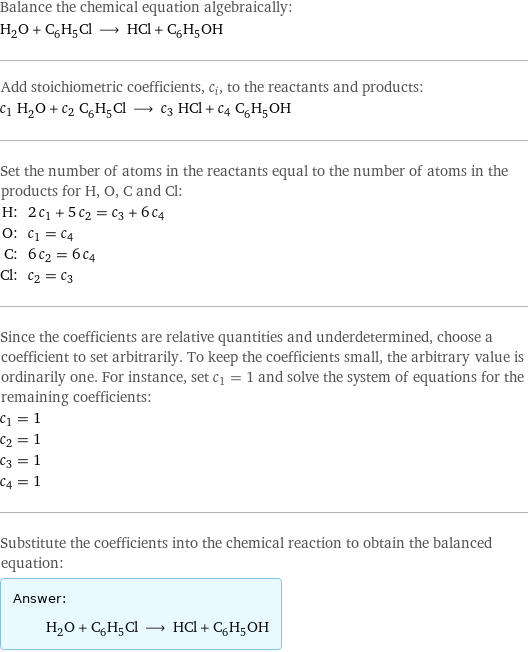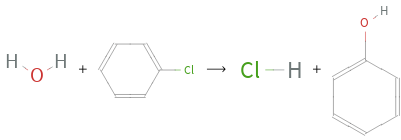Input interpretation

H_2O water + C_6H_5Cl chlorobenzene ⟶ HCl hydrogen chloride + C_6H_5OH phenol
Balanced equation

Balance the chemical equation algebraically: H_2O + C_6H_5Cl ⟶ HCl + C_6H_5OH Add stoichiometric coefficients, c_i, to the reactants and products: c_1 H_2O + c_2 C_6H_5Cl ⟶ c_3 HCl + c_4 C_6H_5OH Set the number of atoms in the reactants equal to the number of atoms in the products for H, O, C and Cl: H: | 2 c_1 + 5 c_2 = c_3 + 6 c_4 O: | c_1 = c_4 C: | 6 c_2 = 6 c_4 Cl: | c_2 = c_3 Since the coefficients are relative quantities and underdetermined, choose a coefficient to set arbitrarily. To keep the coefficients small, the arbitrary value is ordinarily one. For instance, set c_1 = 1 and solve the system of equations for the remaining coefficients: c_1 = 1 c_2 = 1 c_3 = 1 c_4 = 1 Substitute the coefficients into the chemical reaction to obtain the balanced equation: Answer: | | H_2O + C_6H_5Cl ⟶ HCl + C_6H_5OH
Structures

+ ⟶ +
Names

water + chlorobenzene ⟶ hydrogen chloride + phenol
Equilibrium constant
![Construct the equilibrium constant, K, expression for: H_2O + C_6H_5Cl ⟶ HCl + C_6H_5OH Plan: • Balance the chemical equation. • Determine the stoichiometric numbers. • Assemble the activity expression for each chemical species. • Use the activity expressions to build the equilibrium constant expression. Write the balanced chemical equation: H_2O + C_6H_5Cl ⟶ HCl + C_6H_5OH Assign stoichiometric numbers, ν_i, using the stoichiometric coefficients, c_i, from the balanced chemical equation in the following manner: ν_i = -c_i for reactants and ν_i = c_i for products: chemical species | c_i | ν_i H_2O | 1 | -1 C_6H_5Cl | 1 | -1 HCl | 1 | 1 C_6H_5OH | 1 | 1 Assemble the activity expressions accounting for the state of matter and ν_i: chemical species | c_i | ν_i | activity expression H_2O | 1 | -1 | ([H2O])^(-1) C_6H_5Cl | 1 | -1 | ([C6H5Cl])^(-1) HCl | 1 | 1 | [HCl] C_6H_5OH | 1 | 1 | [C6H5OH] The equilibrium constant symbol in the concentration basis is: K_c Mulitply the activity expressions to arrive at the K_c expression: Answer: | | K_c = ([H2O])^(-1) ([C6H5Cl])^(-1) [HCl] [C6H5OH] = ([HCl] [C6H5OH])/([H2O] [C6H5Cl])](../image_source/31290970e206c256433abd9a7df166bf.png)
Construct the equilibrium constant, K, expression for: H_2O + C_6H_5Cl ⟶ HCl + C_6H_5OH Plan: • Balance the chemical equation. • Determine the stoichiometric numbers. • Assemble the activity expression for each chemical species. • Use the activity expressions to build the equilibrium constant expression. Write the balanced chemical equation: H_2O + C_6H_5Cl ⟶ HCl + C_6H_5OH Assign stoichiometric numbers, ν_i, using the stoichiometric coefficients, c_i, from the balanced chemical equation in the following manner: ν_i = -c_i for reactants and ν_i = c_i for products: chemical species | c_i | ν_i H_2O | 1 | -1 C_6H_5Cl | 1 | -1 HCl | 1 | 1 C_6H_5OH | 1 | 1 Assemble the activity expressions accounting for the state of matter and ν_i: chemical species | c_i | ν_i | activity expression H_2O | 1 | -1 | ([H2O])^(-1) C_6H_5Cl | 1 | -1 | ([C6H5Cl])^(-1) HCl | 1 | 1 | [HCl] C_6H_5OH | 1 | 1 | [C6H5OH] The equilibrium constant symbol in the concentration basis is: K_c Mulitply the activity expressions to arrive at the K_c expression: Answer: | | K_c = ([H2O])^(-1) ([C6H5Cl])^(-1) [HCl] [C6H5OH] = ([HCl] [C6H5OH])/([H2O] [C6H5Cl])
Rate of reaction
![Construct the rate of reaction expression for: H_2O + C_6H_5Cl ⟶ HCl + C_6H_5OH Plan: • Balance the chemical equation. • Determine the stoichiometric numbers. • Assemble the rate term for each chemical species. • Write the rate of reaction expression. Write the balanced chemical equation: H_2O + C_6H_5Cl ⟶ HCl + C_6H_5OH Assign stoichiometric numbers, ν_i, using the stoichiometric coefficients, c_i, from the balanced chemical equation in the following manner: ν_i = -c_i for reactants and ν_i = c_i for products: chemical species | c_i | ν_i H_2O | 1 | -1 C_6H_5Cl | 1 | -1 HCl | 1 | 1 C_6H_5OH | 1 | 1 The rate term for each chemical species, B_i, is 1/ν_i(Δ[B_i])/(Δt) where [B_i] is the amount concentration and t is time: chemical species | c_i | ν_i | rate term H_2O | 1 | -1 | -(Δ[H2O])/(Δt) C_6H_5Cl | 1 | -1 | -(Δ[C6H5Cl])/(Δt) HCl | 1 | 1 | (Δ[HCl])/(Δt) C_6H_5OH | 1 | 1 | (Δ[C6H5OH])/(Δt) (for infinitesimal rate of change, replace Δ with d) Set the rate terms equal to each other to arrive at the rate expression: Answer: | | rate = -(Δ[H2O])/(Δt) = -(Δ[C6H5Cl])/(Δt) = (Δ[HCl])/(Δt) = (Δ[C6H5OH])/(Δt) (assuming constant volume and no accumulation of intermediates or side products)](../image_source/9deb8e427386cd3882035ae761b6486c.png)
Construct the rate of reaction expression for: H_2O + C_6H_5Cl ⟶ HCl + C_6H_5OH Plan: • Balance the chemical equation. • Determine the stoichiometric numbers. • Assemble the rate term for each chemical species. • Write the rate of reaction expression. Write the balanced chemical equation: H_2O + C_6H_5Cl ⟶ HCl + C_6H_5OH Assign stoichiometric numbers, ν_i, using the stoichiometric coefficients, c_i, from the balanced chemical equation in the following manner: ν_i = -c_i for reactants and ν_i = c_i for products: chemical species | c_i | ν_i H_2O | 1 | -1 C_6H_5Cl | 1 | -1 HCl | 1 | 1 C_6H_5OH | 1 | 1 The rate term for each chemical species, B_i, is 1/ν_i(Δ[B_i])/(Δt) where [B_i] is the amount concentration and t is time: chemical species | c_i | ν_i | rate term H_2O | 1 | -1 | -(Δ[H2O])/(Δt) C_6H_5Cl | 1 | -1 | -(Δ[C6H5Cl])/(Δt) HCl | 1 | 1 | (Δ[HCl])/(Δt) C_6H_5OH | 1 | 1 | (Δ[C6H5OH])/(Δt) (for infinitesimal rate of change, replace Δ with d) Set the rate terms equal to each other to arrive at the rate expression: Answer: | | rate = -(Δ[H2O])/(Δt) = -(Δ[C6H5Cl])/(Δt) = (Δ[HCl])/(Δt) = (Δ[C6H5OH])/(Δt) (assuming constant volume and no accumulation of intermediates or side products)
Chemical names and formulas

| water | chlorobenzene | hydrogen chloride | phenol formula | H_2O | C_6H_5Cl | HCl | C_6H_5OH Hill formula | H_2O | C_6H_5Cl | ClH | C_6H_6O name | water | chlorobenzene | hydrogen chloride | phenol